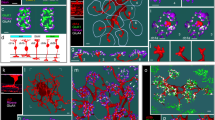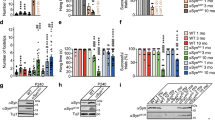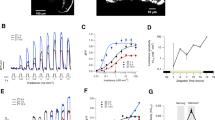Abstract
In vision, balance and hearing, sensory receptor cells translate sensory stimuli into electrical signals whose amplitude is graded with stimulus intensity. The output synapses of these sensory neurons must provide fast signaling to follow rapidly changing stimuli while also transmitting graded information covering a wide range of stimulus intensity and must be able to sustain this signaling for long time periods. To meet these demands, specialized machinery for transmitter release, the synaptic ribbon, has evolved at the synaptic outputs of these neurons. We found that acute disruption of synaptic ribbons by photodamage to the ribbon markedly reduced both sustained and transient components of neurotransmitter release in mouse bipolar cells and salamander cones without affecting the ultrastructure of the ribbon or its ability to localize synaptic vesicles to the active zone. Our results indicate that ribbons mediate both slow and fast signaling at sensory synapses and support an additional role for the synaptic ribbon in priming vesicles for exocytosis at active zones.
This is a preview of subscription content, access via your institution
Access options
Subscribe to this journal
Receive 12 print issues and online access
$259.00 per year
only $21.58 per issue
Buy this article
- Purchase on SpringerLink
- Instant access to full article PDF
Prices may be subject to local taxes which are calculated during checkout






Similar content being viewed by others
References
Cowan, W.M., Sudhof, T.C. & Stevens, C.F. Synapses (Johns Hopkins University Press, Baltimore, Maryland, 2001).
LoGiudice, L. & Matthews, G. The role of ribbons at sensory synapses. Neuroscientist 15, 380–391 (2009).
Lenzi, D. & von Gersdorff, H. Structure suggests function: the case for synaptic ribbons as exocytotic nanomachines. Bioessays 23, 831–840 (2001).
Khimich, D. et al. Hair cell synaptic ribbons are essential for synchronous auditory signaling. Nature 434, 889–894 (2005).
Davis, G.W. & Bezprozvanny, I. Maintaining the stability of neural function: a homeostatic hypothesis. Annu. Rev. Physiol. 63, 847–869 (2001).
Surrey, T. et al. Chromophore-assisted light inactivation and self-organization of microtubules and motors. Proc. Natl. Acad. Sci. USA 95, 4293–4298 (1998).
Hoffman-Kim, D., Diefenbach, T.J., Eustace, B.K. & Jay, D.G. Chromophore-assisted laser inactivation. Methods Cell Biol. 82, 335–354 (2007).
Zenisek, D., Horst, N.K., Merrifield, C., Sterling, P. & Matthews, G. Visualizing synaptic ribbons in the living cell. J. Neurosci. 24, 9752–9759 (2004).
Frank, T., Khimich, D., Neef, A. & Moser, T. Mechanisms contributing to synaptic Ca2+ signals and their heterogeneity in hair cells. Proc. Natl. Acad. Sci. USA 106, 4483–4488 (2009).
LoGiudice, L., Sterling, P. & Matthews, G. Mobility and turnover of vesicles at the synaptic ribbon. J. Neurosci. 28, 3150–3158 (2008).
Bartoletti, T.M., Babai, N. & Thoreson, W.B. Vesicle pool size at the salamander cone ribbon synapse. J. Neurophysiol. 103, 419–423 (2010).
Choi, S.Y., Jackman, S., Thoreson, W.B. & Kramer, R.H. Light regulation of Ca2+ in the cone photoreceptor synaptic terminal. Vis. Neurosci. 25, 693–700 (2008).
Singer, J.H., Lassova, L., Vardi, N. & Diamond, J.S. Coordinated multivesicular release at a mammalian ribbon synapse. Nat. Neurosci. 7, 826–833 (2004).
Tsukamoto, Y., Morigiwa, K., Ueda, M. & Sterling, P. Microcircuits for night vision in mouse retina. J. Neurosci. 21, 8616–8623 (2001).
Singer, J.H. & Diamond, J.S. Sustained Ca2+ entry elicits transient postsynaptic currents at a retinal ribbon synapse. J. Neurosci. 23, 10923–10933 (2003).
Snellman, J., Zenisek, D. & Nawy, S. Switching between transient and sustained signaling at the rod bipolar-AII amacrine cell synapse of the mouse retina. J. Physiol. (Lond.) 587, 2443–2455 (2009).
Mørkve, S.H., Veruki, M.L. & Hartveit, E. Functional characteristics of non-NMDA-type ionotropic glutamate receptor channels in AII amacrine cells in rat retina. J. Physiol. (Lond.) 542, 147–165 (2002).
Veruki, M.L., Mørkve, S.H. & Hartveit, E. Functional properties of spontaneous EPSCs and non-NMDA receptors in rod amacrine (AII) cells in the rat retina. J. Physiol. (Lond.) 549, 759–774 (2003).
von Gersdorff, H., Vardi, E., Matthews, G. & Sterling, P. Evidence that vesicles on the synaptic ribbon of retinal bipolar neurons can be rapidly released. Neuron 16, 1221–1227 (1996).
Veruki, M.L., Morkve, S.H. & Hartveit, E. Activation of a presynaptic glutamate transporter regulates synaptic transmission through electrical signaling. Nat. Neurosci. 9, 1388–1396 (2006).
Palmer, M.J., Hull, C., Vigh, J. & von Gersdorff, H. Synaptic cleft acidification and modulation of short-term depression by exocytosed protons in retinal bipolar cells. J. Neurosci. 23, 11332–11341 (2003).
Jarsky, T., Tian, M. & Singer, J.H. Nanodomain control of exocytosis is responsible for the signaling capability of a retinal ribbon synapse. J. Neurosci. 30, 11885–11895 (2010).
DeVries, S.H. Exocytosed protons feedback to suppress the Ca2+ current in mammalian cone photoreceptors. Neuron 32, 1107–1117 (2001).
Molloy, D.P. et al. Structural determinants present in the C-terminal binding protein binding site of adenovirus early region 1A proteins. J. Biol. Chem. 273, 20867–20876 (1998).
Schmitz, F., Konigstorfer, A. & Sudhof, T.C. RIBEYE, a component of synaptic ribbons: a protein's journey through evolution provides insight into synaptic ribbon function. Neuron 28, 857–872 (2000).
Bonazzi, M. et al. CtBP3/BARS drives membrane fission in dynamin-independent transport pathways. Nat. Cell Biol. 7, 570–580 (2005).
Rabl, K., Cadetti, L. & Thoreson, W.B. Kinetics of exocytosis is faster in cones than in rods. J. Neurosci. 25, 4633–4640 (2005).
Singer, J.H. & Diamond, J.S. Vesicle depletion and synaptic depression at a mammalian ribbon synapse. J. Neurophysiol. 95, 3191–3198 (2006).
Heidelberger, R. Adenosine triphosphate and the late steps in calcium-dependent exocytosis at a ribbon synapse. J. Gen. Physiol. 111, 225–241 (1998).
Heidelberger, R., Sterling, P. & Matthews, G. Roles of ATP in depletion and replenishment of the releasable pool of synaptic vesicles. J. Neurophysiol. 88, 98–106 (2002).
Rizo, J. & Rosenmund, C. Synaptic vesicle fusion. Nat. Struct. Mol. Biol. 15, 665–674 (2008).
tom Dieck, S. et al. Molecular dissection of the photoreceptor ribbon synapse: physical interaction of Bassoon and RIBEYE is essential for the assembly of the ribbon complex. J. Cell Biol. 168, 825–836 (2005).
Dick, O. et al. The presynaptic active zone protein bassoon is essential for photoreceptor ribbon synapse formation in the retina. Neuron 37, 775–786 (2003).
Frank, T. et al. Bassoon and the synaptic ribbon organize Ca2+ channels and vesicles to add release sites and promote refilling. Neuron 68, 724–738 (2010).
Zenisek, D., Steyer, J.A. & Almers, W. Transport, capture and exocytosis of single synaptic vesicles at active zones. Nature 406, 849–854 (2000).
Zenisek, D. Vesicle association and exocytosis at ribbon and extraribbon sites in retinal bipolar cell presynaptic terminals. Proc. Natl. Acad. Sci. USA 105, 4922–4927 (2008).
Midorikawa, M., Tsukamoto, Y., Berglund, K., Ishii, M. & Tachibana, M. Different roles of ribbon-associated and ribbon-free active zones in retinal bipolar cells. Nat. Neurosci. 10, 1268–1276 (2007).
Coggins, M.R., Grabner, C.P., Almers, W. & Zenisek, D. Stimulated exocytosis of endosomes in goldfish retinal bipolar neurons. J. Physiol. (Lond.) 584, 853–865 (2007).
Miller, R.F., Gottesman, J., Henderson, D., Sikora, M. & Kolb, H. Pre- and postsynaptic mechanisms of spontaneous, excitatory postsynaptic currents in the salamander retina. Prog. Brain Res. 131, 241–253 (2001).
Wong-Riley, M.T. Synaptic orgnization of the inner plexiform layer in the retina of the tiger salamander. J. Neurocytol. 3, 1–33 (1974).
Grünert, U., Haverkamp, S., Fletcher, E.L. & Wassle, H. Synaptic distribution of ionotropic glutamate receptors in the inner plexiform layer of the primate retina. J. Comp. Neurol. 447, 138–151 (2002).
Hull, C., Studholme, K., Yazulla, S. & von Gersdorff, H. Diurnal changes in exocytosis and the number of synaptic ribbons at active zones of an ON-type bipolar cell terminal. J. Neurophysiol. 96, 2025–2033 (2006).
Heidelberger, R., Heinemann, C., Neher, E. & Matthews, G. Calcium dependence of the rate of exocytosis in a synaptic terminal. Nature 371, 513–515 (1994).
von Gersdorff, H. & Matthews, G. Dynamics of synaptic vesicle fusion and membrane retrieval in synaptic terminals. Nature 367, 735–739 (1994).
Thoreson, W.B., Rabl, K., Townes-Anderson, E. & Heidelberger, R. A highly Ca2+-sensitive pool of vesicles contributes to linearity at the rod photoreceptor ribbon synapse. Neuron 42, 595–605 (2004).
Paillart, C., Li, J., Matthews, G. & Sterling, P. Endocytosis and vesicle recycling at a ribbon synapse. J. Neurosci. 23, 4092–4099 (2003).
Johnson, S.L., Thomas, M.V. & Kros, C.J. Membrane capacitance measurement using patch clamp with integrated self-balancing lock-in amplifier. Pflugers Arch. 443, 653–663 (2002).
Acknowledgements
The authors would like to thank S. Mentone for electron microscopy. This work was funded by US National Institutes of Health grants R01 EY003821 (G.M.), EY018111 (D.Z.) and EY10542 (W.T.), Yale University Vision Core grant EY000785 (M. Crair) and Research to Prevent Blindness (W.T.).
Author information
Authors and Affiliations
Contributions
J.S. conducted the experiments shown in Figures 2, 3, 4 and 6, analyzed the data shown in Figures 2, 3 and 4 and contributed to the editing and writing of the manuscript. B.M. performed the experiments and analysis shown in Figure 3. N.B., T.M.B. and W.T. performed and analyzed the experiments shown in Figure 5. W.T. also contributed to the editing and writing of the manuscript. W.A. performed the electron microscopy shown in Figure 6 and the Supplementary Figures. A.F. performed experiments shown in Figure 1. G.M. oversaw the electron microscopy experiments and contributed to the editing and writing of the manuscript. D.Z. prepared the manuscript, oversaw the project, performed experiments shown in Figure 1 and performed the analysis shown in Figures 1 and 6.
Corresponding author
Ethics declarations
Competing interests
The authors declare no competing financial interests.
Supplementary information
Supplementary Text and Figures
Supplementary Figures 1 and 2 (PDF 2117 kb)
Rights and permissions
About this article
Cite this article
Snellman, J., Mehta, B., Babai, N. et al. Acute destruction of the synaptic ribbon reveals a role for the ribbon in vesicle priming. Nat Neurosci 14, 1135–1141 (2011). https://doi.org/10.1038/nn.2870
Received:
Accepted:
Published:
Issue date:
DOI: https://doi.org/10.1038/nn.2870
This article is cited by
-
Transmission at rod and cone ribbon synapses in the retina
Pflügers Archiv - European Journal of Physiology (2021)
-
Dynamic assembly of ribbon synapses and circuit maintenance in a vertebrate sensory system
Nature Communications (2019)
-
AMPA receptors at ribbon synapses in the mammalian retina: kinetic models and molecular identity
Brain Structure and Function (2018)
-
In Vivo Ribbon Mobility and Turnover of Ribeye at Zebrafish Hair Cell Synapses
Scientific Reports (2017)
-
Subcortical cytoskeleton periodicity throughout the nervous system
Scientific Reports (2016)



